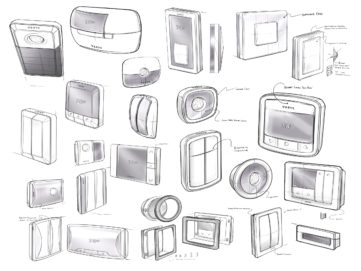
Smart Home
Control System

Consumer electronics design of a product platform for home security and lighting control
Summary:
Designing a platform for smart home controllers results in a unique consumer electronics design challenge. Differentiating by design of a series of wireless home control devices around a newly licensed technology, this project featured creative constraints imposed by an energy harvesting mechanism.
A piezoelectric (energy harvesting) sub assembly was sourced from a third party vendor. As the envelop and subsequent user scenarios would be affected by the specifications of this pre-defined sourced component, establishing a minimal profile and strong visual brand language would define the consumer electronics design platform’s overall success.
Responsibilities:

Concept Development
Following a typical design process, we conduct some initial category research and followed up with traditional Industrial Design concept sketching with pen and paper.

Visual Brand Language
As concepts were refined, critiqued, and selected for further development, we coordinated the new technology, mechanical engineering, and design efforts to define the platform’s overall design intent, brand language, color materials and finishes.

Prototypes & Model-Making
3D CAD modelling, hand modelling, and 3D printing are simultaneously employed techniques to put objects in hand and on the table for further review, refinement and stakeholder alignment. We scaled to meet the expanding scope of this consumer electronics design platform’s launch.
Gallery:





While the design and brand development process was customized to address the changing needs of the customer and supply chain pressures, the needs of the end user were kept in focus as our guiding principles with which to measure a successful outcome. Principal Design’s 5 step process is a framework that guides the design team and encourages opportunity exploration, yet maintains purposefully guided action towards well defined goals.

DESIGN PROCESS HIGHLIGHTS
The success of our 5 step, gated development process is bolstered by a purposeful, user-centered design approach. Our five stages have historically proven to leverage the product design practice. Principal Design’s purpose-driven frameworks are intended to reduce risk, while balancing exploration with execution. The general design strategy is divergent to leverage resources and discovery, while convergent to make the best final selections. Phase-gates inherent to the process are an opportunity to reflect, and then refine the product design for maximum impact.